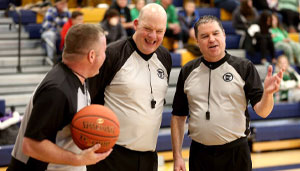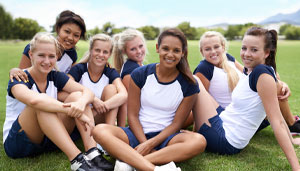Overcoming the Barriers of Participation for Students with Disabilities
By John Register on January 31, 2017 Coaches PrintThe Playground
The school bell rang and I quickly pushed away from my desk and bolted for the door. My favorite game, kickball, was about to start on the junior high playground. All the potential players (student-athletes) lined up to see who would get picked. I was usually one of the captains and, with my opponent, we would take turns picking teams in hierarchical order until all rosters positions were filled.
Those who were not picked went on to play other sports. But there was one group that I am ashamed to say I never even considered. Those were the kids with disabilities. I really don’t even recall if we had any on the playground. But that does not excuse me from not at least being aware of a population that almost always gets overlooked.
Sports scenes like these happen across America. They are often the first entry point and the building blocks to a pipeline of, and not only to, higher levels of sport. In addition, they are a gateway to helping those who play the games see the inherent value that sports plays in our society.
We don’t pick them for the K-8 activities and we don’t pick them to participate on our sports teams. Why not?
Attitudinal and Physical Barriers
There are two distinct barriers to sport participation in relation to students with disabilities. These two barriers are attitudinal and physical. I am reminded of an episode of the X-Files in which Agent Mulder said he wished that he had a disability because society does not expect much from people with disabilities. His point was that he would not have to work as hard. Maybe he could even sit at home and collect a government check.
People with disabilities are not inferior, nor do they seek pity. They do not want to be worshipped as heroes because of some incredible feat they did that you did not think they should have been able to do based on your limited perception of what is possible for that individual.
A person with a disability wants to be viewed for who they are and not for what society determines their disability to be. In the disability community, there are two schools of thought as it pertains to people with disabilities.
The first is that, “I am a person. I am not my disability.” This generally is stated when people make a judgement about a person based on their appearance. Or, they will refer to people in wheelchairs as, “All wheelchairs please line up over here.” If you replace the identifier wheelchair with another modifier you can see how insensitive that might be to the user. It wasn’t that long ago when we said, “All black people line up over here.” What if we did that with weight? “All those who are “fat” please line up over here.” In order to overcome the attitudinal barrier, we should see the person and not the disability.
The second is that, “I am not a disabled person at all, but rather it is my environment that disables me.” The example for this thought process is if I use wheelchair for my mode of getting around because my legs don’t work, then the only limiting factor for me are the steps in front of me, or the out of service elevator. The environment disables me. If there were a ramp or an elevator I would be able to make it to my respective appointment on time.
The Benefits of sports are limitless. Sports are an extremely valuable part of the overall educational program and result in improved health, social benefits, time management, increased positive body image and higher self-esteem. Sports teach student-athletes how to win and lose and that in both instances you must demonstrate great sportsmanship.
Paralympic Eligible vs Special Olympic Eligible
There is vast confusion around and mislabeling of youth with disabilities. Again, there are two categories of those who need to participate in sport. Youth with an intellectual disability such as Down syndrome may or may not have the full integration capacity, although we see it being done time and again in schools. A young man with Down syndrome, who was under the tutelage of my coach, hit five three-pointers in the last few seconds of a game.
Paralympic eligible means that these youths have a physical disability. They are blind, paralyzed, have cerebral palsy, dwarfism, and are amputees. Most of these youths are not in special classes, but rather are mainstreamed into classrooms. These are the kids who do not get picked when it comes to playing sport. They begin to develop their own caste system.
If you are building a program of inclusion, and sport is the basis for that inclusion, the challenge will be to get youths to come out and play the game.
OCR Guidelines
On January 25, 2013, the Office of Civil Rights (OCR) wrote the “Dear Colleague” Letter because many schools were falling short of giving students with disabilities the opportunity to participate. The letter reminded schools that sports are participatory in nature and that all youth should learn the valuable lessons that sports offer. It also noted that those valuable lessons should not be only for those who are non-disabled. It was written to “Ensure that students with disabilities consistently have opportunities to participate in extracurricular athletics equal to those of other students.” Again, the OCR guidelines are just a reminder of the laws that are on the books for schools K-12 to provide sports opportunities for all student athletes regardless of ability.
Challenges
The greatest challenge to identifying and getting the Paralympic-eligible student-athlete out to play the sport is to ensure that they and their parents understand the school’s sincerity. Remember most of these youths have never asked to play.
Even if you build a program that is parallel and you ask a youth in the hallway to come out, most likely they won’t. Why? Because they were never asked to play before. There will be questions. Why do you want me out? What do I have to do? You must recruit them like you recruit the big strong male or female athlete that just transferred into your school.
You must salivate over these potential athletes in the same way. If you are not, you just do not understand what you are looking at.
You may have a Paralympian in your midst and you don’t know it because you are not educated on the Paralympic athlete
Call to action
Get engaged by becoming aware of how you can impact a youth with a disabilities life. Read over the OCR Guidelines so you know exactly what you it calls for.
Go to the U.S. Paralympics website and learn what sports are offered and to what disability demographic. Then scour your hallways to find people to put on your teams. However, also speak with your school administration to see how you can offer more programs for all students.
Consider flipping a sport. Instead of doing a learning module on volleyball, do the learning module on sitting volleyball. Instead of only offering the standup basketball model, build a sitting component. Administrators can also look to build a curriculum around the module sitting down in a wheelchair and experiencing how much upper-body strength it takes to shoot a basketball from a seated position to 11 feet to make a 10-foot basket.
Or better yet, insert a sport like goal ball, which is 3v3 played on a court that is a little larger than a volleyball court, and is totally blacked out. The ball, which has a bell on the inside, is rolled toward the opposing goal. The opposing team tries to stop the ball by using their bodies as human shields.
On your sports teams, there are people walking your halls who have a Paralympic-eligible disability. For them to compete in most individual sports there are minimal rules that are needed to be adjusted to have participation.
Adding an additional heat to the high school track program or swim meet does not take up too much time.
The enhancement for the entire team is that they are part of the team. The other benefit is once the school is educated enough to understand the records in Paralympic sport, the athlete’s performance can be measured against a comparable athlete for the team they are vying to make.
Tobi Fawehinmi found the sport of track and field. He currently is jumping at the University of Texas at Arlington. After being discovered by a Paralympic coach jumping at his local high school. he exploded onto the Paralympic scene and earned fifth place in the triple jump and 10th place in the long jump at the 2012 Paralympic Games.
Fawehinmi stated that he did not even know about the opportunity of earning a spot at the Paralympic Games. How many others don’t know about the opportunity because the administrators and coaches do not know about the opportunity?
What a great opportunity we have to ensure that youth with disability have an opportunity to finally be picked, not with a sympathy but because they have an opportunity to experience organic growth like their non-disabled peers.
John Register
John Register is a four-time track and field All-American, as well as a Gulf War Veteran and an amputee turned Paralympic Long Jump Silver Medalist. He currently is the associate director for the U.S. Paralympics, a division of the United States Olympic Committee (USOC).
Most Recent Articles
- nfhs news NFHS Learning Center Delivers 25 Millionth Course
- Track & Field/Cross Country article Effective Communication with Athletes and Coaches
- nfhs news Player Equipment Changes Highlight 2025 High School Football Rules Revisions
- Player Equipment Changes Highlight 2025 High School Football Rules Revisions
- nfhs news Judgment Call on Second Contact Eliminated in High School Volleyball






